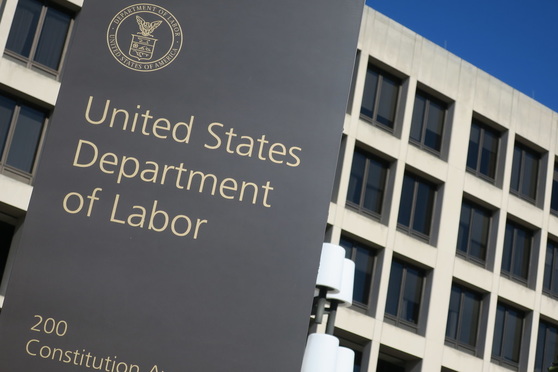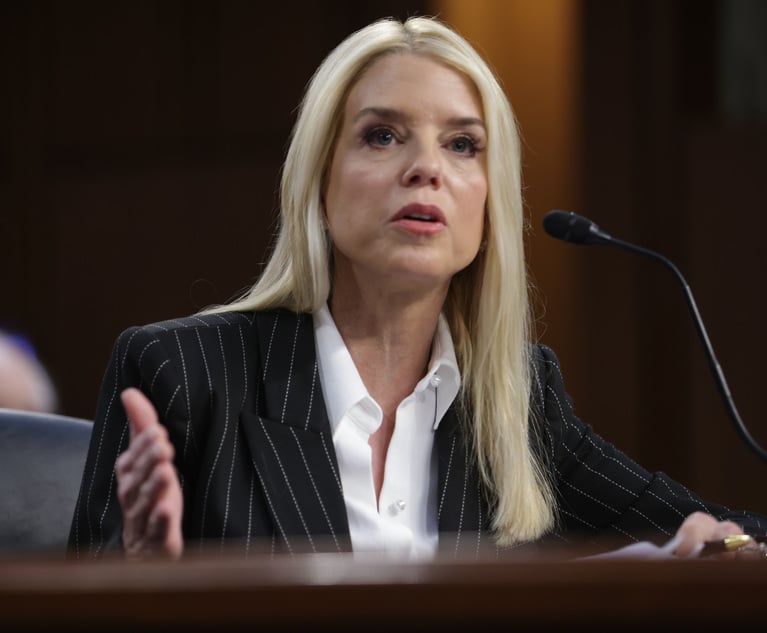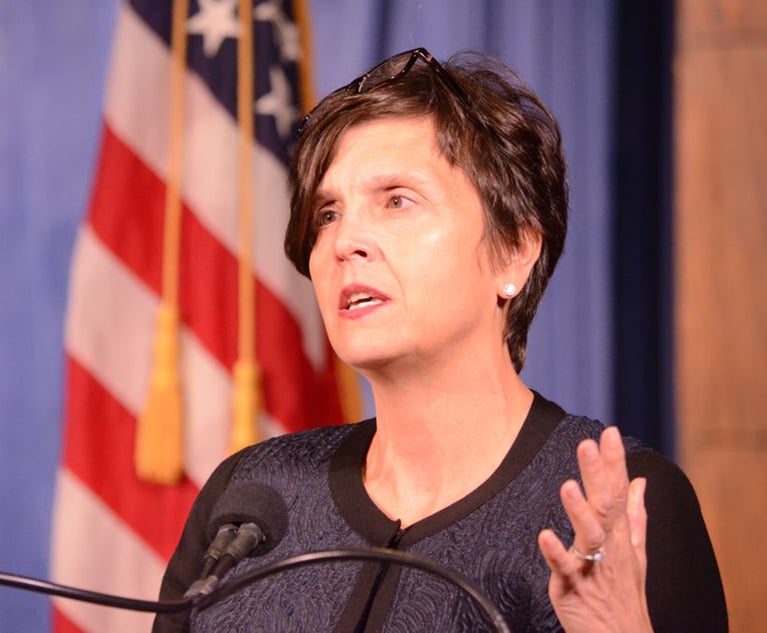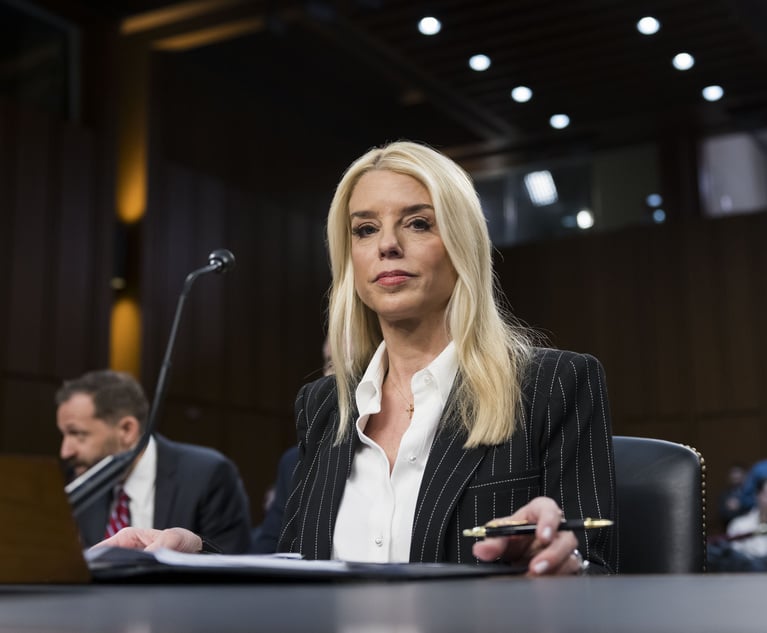Early Thoughts on Labor Department's New Overtime Proposal
Management-side and workers' rights advocates have a lot to say about the U.S. Labor Department's new proposal to boost overtime eligibility. Here's a snapshot.
March 08, 2019 at 02:43 PM
8 minute read
 U.S. Labor Department headquarters in Washington, D.C. Photo: Mike Scarcella
U.S. Labor Department headquarters in Washington, D.C. Photo: Mike Scarcella
The U.S. Labor Department has unveiled a long-awaited proposal that makes more than 1 million workers eligible for overtime. The proposal sets up renewed tension for stakeholders and will eventually shake up how employers pay and classify their workforce.
Currently, employees with a salary below $23,660 a year must be paid overtime—time and a half their hourly rate—if they work more than 40 hours per week. That salary level was set in 2004. A 2016 proposal by the Obama administration, which was blocked by a Texas federal judge, would have doubled that salary threshold to roughly $47,000. Unlike the Obama measure, the new proposal does not call for automatic adjustments.
That rule was challenged and struck down by a federal court in Texas in 2016, and since then there has been uncertainty. The U.S. Court of Appeals for the Fifth Circuit held off on deciding on the measure while the department revised the rule.
Labor Secretary Alexander Acosta acknowledged there was a need to increase the threshold to help more workers, but he said the Obama-era move to double to standard went too far. He also told the Fifth Circuit that the department has a right to set a rule, which was in contention.
The department will next ask for public comment on the proposal. To develop the proposal, more than 200,000 groups, stakeholders and individuals submitted comments. Already, interest groups and management-side attorneys are weighing in on this development. Here is a collection of what they are saying.
>> Allan Bloom, head of Proskauer Rose's wage and hour group, said the salary threshold was higher than many employers expected. He pinpointed that the threshold for exemption as a “highly compensated employee” would jump from $100,000 to $147,414 in total annual compensation. That's higher than the level proposed by the Obama administration. “So, all in all, a fairly straightforward proposed new rule that won't make a difference to employers in states with already-higher salary minimums for exemption (like New York and California),” Bloom said. He said the rule wouldn't likely be completed until fall 2019.
>> Tammy McCutchen, a principal in Littler Mendelson's Washington, D.C., office and former administrator of the U.S. Department of Labor's wage and hour division, said: “The proposed salary level seems reasonable and should be workable in every industry and in every state. I am also glad to see that DOL has committed in the proposal to regular updates to the salary level, but only after the public has an opportunity to comment as required under federal law. Now the department needs to make sure that the next stage in the process moves expeditiously so the rule can be finalized this year.”
➤➤ Get employment law news and commentary straight to your in-box with Labor of Law, a new Law.com briefing. Learn more and sign up here.
>> Workers' rights groups, which had supported the Obama administration's overtime push, were disappointed about the threshold Acosta settled on. The Economic Policy Institute said the Labor Department met with more than 200 organizations to create the higher level before the Obama administration proposed a new threshold. The 2016 rule was not overly expansive, the group said. It covered far fewer workers than the rule did historically. For example in 1975, more than 60 percent of full-time salaried workers earned below the threshold. That dropped to 7 percent in 2016. The 2016 rule would have covered 33 percent. “That means this administration is effectively turning its back on millions of workers. Trump and his cabinet are again siding with corporate interests over those of working people. We strongly oppose this and any efforts to weaken the criteria set forth in the 2016 final rule for defining who qualifies for exemption from overtime protections. DOL does not need to undertake a new rulemaking—they just need to defend the 2016 rule, and support middle-class workers who badly need a raise.”
>> Fisher & Phillips said in a client advisory that said some of the same flaws exist in the new proposal that were struck down by the Texas court. The attorneys say that it's possible litigation will be filed against the lower figure. “If we've learned anything from the saga that accompanied the release and subsequent controversy over Overtime Rule 1.0, it's that this is a process,” said Marty Heller, of counsel in Atlanta. “Many twists and turns might occur before this proposed rule is finalized. Do not run out tomorrow and make changes to your compensation structure based on what is simply a proposal.” Some employers made changes in 2016 in anticipation of the new rule.
 Susan Harthill
Susan Harthill>> Susan Harthill, a Morgan, Lewis & Bockius partner, who previously served as deputy solicitor for national operations at the Labor Department, said the actual salary level will remain the most controversial and probably generate the most in the comments. She advised that employers who comment should take the opportunity to participate in the process and think about all aspects of the proposal, its impact on their business and the methodology used. She said while many employers did adjust to the 2016 rule, many did not. She said some employers may decide to advised that they wait and see what the final rule provides because there will be a lead time before it becomes effective. How the rule is actually enforced to take action will also likely be challenged. “They can watch and wait and consider submitting comments,” she said.
>> Ryan Glasgow, partner at Hunton Andrews Kurth, called the proposal “a much more modest approach” to that of the Obama administration. He noted two ways the rule is different from 2016: The methodology used is the same as that in 2004, and the 2016 rule used a national average and relied upon a higher percentage. It would also require notice and comment rulemaking every four years to update the salary level. He said employers had options to satisfy the rule, as well. He said they could satisfy the requirement through bonuses and incentive programs of make a yearly catch-up payment.
>> Robert Boonin, wage and hour defense attorney at Dykema Gossett, said: “The DOL also appears to have taken the least controversial tact by not including periodic adjustments or providing variances for different regions or sectors, likely with the hope that finalizing the regulation will be feasible before the 2020 election year. The question now will be if the limited proposal is considered reasonable enough to avoid serious challenges, if the Department supported its position for having a salary level standard on stronger legal grounds than the court found it failed to do in 2016, and whether Congress will chime in some manner.”
>> Ryan Mick, partner at Dorsey & Whitney, said, “Employers who recall the feeling of panic when the Obama administration issued its Final Rule doubling the salary basis threshold in May 2016 will breathe a sigh of relief over the much smaller increase proposed by the Department of Labor yesterday. In fact, for many larger employers, or employers that made changes to comply with the 2016 Final Rule before it was enjoined, yesterday's announcement will be a non-event. Nonetheless, yesterday's proposed rule will still have a significant impact on many businesses, as the Department of Labor estimates that more than 1 million employees will have to receive pay raises in 2020 or become eligible for overtime. Small and medium-sized businesses may bear the brunt of that impact.” He said employers should not forget that the Department of Labor's proposed rule has no bearing on state law.
Read more:
US Labor Judge Warns Lawyers About 'Tone' in Oracle Discrimination Case
Judge's Pay-Data Ruling, a Trump Rebuke, Puts New Squeeze on Employers
Labor Dept. Attorney Sanctioned for 'Bad Judgment' in Litigating Private Suit
This content has been archived. It is available through our partners, LexisNexis® and Bloomberg Law.
To view this content, please continue to their sites.
Not a Lexis Subscriber?
Subscribe Now
Not a Bloomberg Law Subscriber?
Subscribe Now
NOT FOR REPRINT
© 2025 ALM Global, LLC, All Rights Reserved. Request academic re-use from www.copyright.com. All other uses, submit a request to [email protected]. For more information visit Asset & Logo Licensing.
You Might Like
View All
Skadden and Steptoe, Defending Amex GBT, Blasts Biden DOJ's Antitrust Lawsuit Over Merger Proposal
4 minute read
'Lack of Independence' or 'Tethered to the Law'? Witnesses Speak on Bondi
4 minute read
Trending Stories
- 1Reviewing Judge Merchan's Unconditional Discharge
- 2With New Civil Jury Selection Rule, Litigants Should Carefully Weigh Waiver Risks
- 3Young Lawyers Become Old(er) Lawyers
- 4Caught In the In Between: A Legal Roadmap for the Sandwich Generation
- 5Top 10 Developments, Lessons, and Reminders of 2024
Who Got The Work
J. Brugh Lower of Gibbons has entered an appearance for industrial equipment supplier Devco Corporation in a pending trademark infringement lawsuit. The suit, accusing the defendant of selling knock-off Graco products, was filed Dec. 18 in New Jersey District Court by Rivkin Radler on behalf of Graco Inc. and Graco Minnesota. The case, assigned to U.S. District Judge Zahid N. Quraishi, is 3:24-cv-11294, Graco Inc. et al v. Devco Corporation.
Who Got The Work
Rebecca Maller-Stein and Kent A. Yalowitz of Arnold & Porter Kaye Scholer have entered their appearances for Hanaco Venture Capital and its executives, Lior Prosor and David Frankel, in a pending securities lawsuit. The action, filed on Dec. 24 in New York Southern District Court by Zell, Aron & Co. on behalf of Goldeneye Advisors, accuses the defendants of negligently and fraudulently managing the plaintiff's $1 million investment. The case, assigned to U.S. District Judge Vernon S. Broderick, is 1:24-cv-09918, Goldeneye Advisors, LLC v. Hanaco Venture Capital, Ltd. et al.
Who Got The Work
Attorneys from A&O Shearman has stepped in as defense counsel for Toronto-Dominion Bank and other defendants in a pending securities class action. The suit, filed Dec. 11 in New York Southern District Court by Bleichmar Fonti & Auld, accuses the defendants of concealing the bank's 'pervasive' deficiencies in regards to its compliance with the Bank Secrecy Act and the quality of its anti-money laundering controls. The case, assigned to U.S. District Judge Arun Subramanian, is 1:24-cv-09445, Gonzalez v. The Toronto-Dominion Bank et al.
Who Got The Work
Crown Castle International, a Pennsylvania company providing shared communications infrastructure, has turned to Luke D. Wolf of Gordon Rees Scully Mansukhani to fend off a pending breach-of-contract lawsuit. The court action, filed Nov. 25 in Michigan Eastern District Court by Hooper Hathaway PC on behalf of The Town Residences LLC, accuses Crown Castle of failing to transfer approximately $30,000 in utility payments from T-Mobile in breach of a roof-top lease and assignment agreement. The case, assigned to U.S. District Judge Susan K. Declercq, is 2:24-cv-13131, The Town Residences LLC v. T-Mobile US, Inc. et al.
Who Got The Work
Wilfred P. Coronato and Daniel M. Schwartz of McCarter & English have stepped in as defense counsel to Electrolux Home Products Inc. in a pending product liability lawsuit. The court action, filed Nov. 26 in New York Eastern District Court by Poulos Lopiccolo PC and Nagel Rice LLP on behalf of David Stern, alleges that the defendant's refrigerators’ drawers and shelving repeatedly break and fall apart within months after purchase. The case, assigned to U.S. District Judge Joan M. Azrack, is 2:24-cv-08204, Stern v. Electrolux Home Products, Inc.
Featured Firms
Law Offices of Gary Martin Hays & Associates, P.C.
(470) 294-1674
Law Offices of Mark E. Salomone
(857) 444-6468
Smith & Hassler
(713) 739-1250











